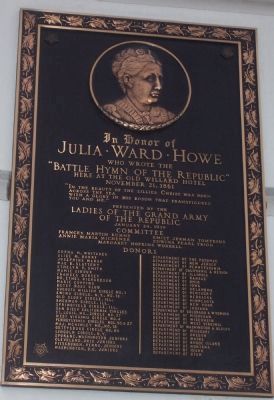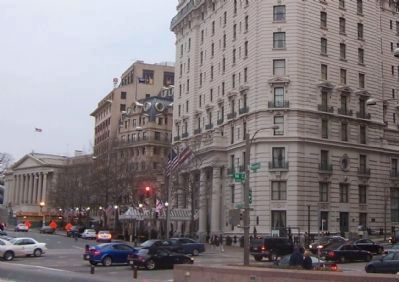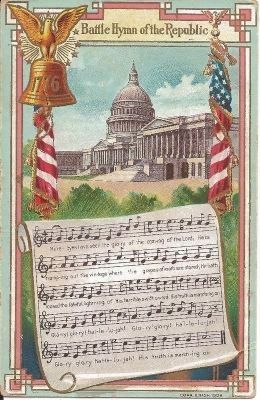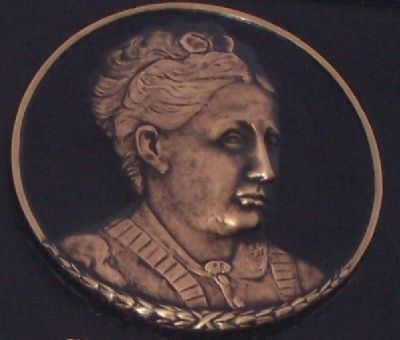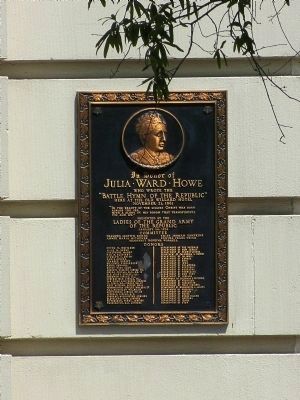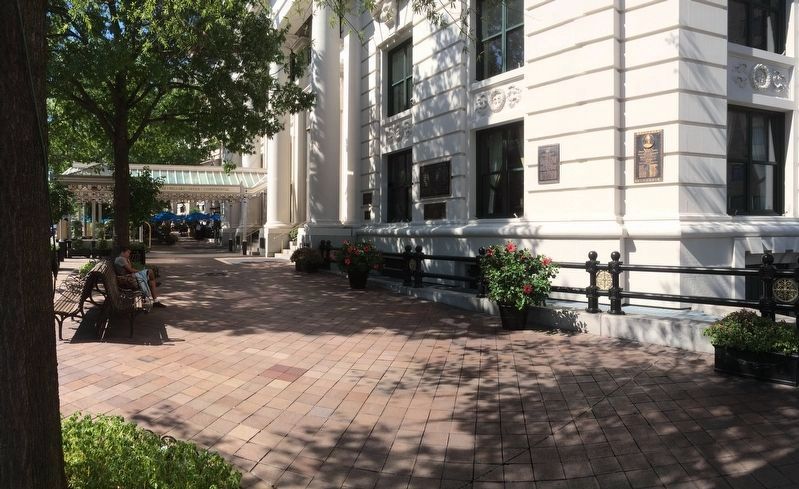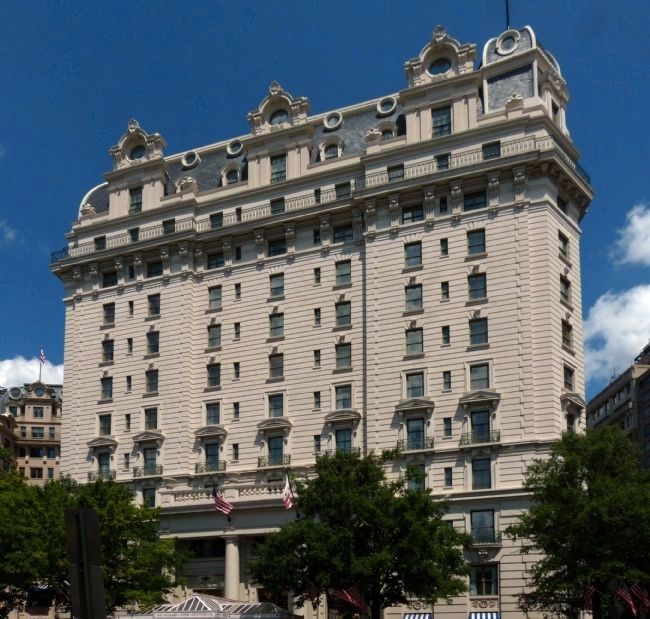Penn Quarter in Northwest Washington in Washington, District of Columbia — The American Northeast (Mid-Atlantic)
Julia Ward Howe
Inscription.
Julia Ward Howe
who wrote the
"Battle Hymn of the Republic"
here at the Old Willard Hotel
November 21, 1861
"In the beauty of the lillies Christ was born
across the sea
with a glory in his bosom that transfigures
you and me."
Presented by the
Ladies of the Grand Army
of the Republic
January 24, 1938
Committee
Frances Martin Kuhns - Emily Jerman Tompkins
Annie Maria Michener - Edina Pearl Trigg
Margret Hopkins Worrell
Donors
Orpha M. Whitaker | Department of the Potomac
Alice M. Burke | Department of New Jersey
Josephine Mahar | Department of Pennsylvania
Mae B. Slattery | Department of California & Nevada
Ethelyn P. Smith | Department of Illinois
Mamie Giroux | Department of Kansas
Frances Dorsey | Department of Ohio
Dr. Ethel Richardson | Department of Iowa
Marie Copping | Department of Oklahoma
Betsy Ross Club | Department of Kentucky
Augusta Willich Circle No. 1 | Department of Nebraska
Ewing Circle, N.Y., No 10 | Department of Minnesota
Old Glory Circle, Ill. | Department of New York
Sherman Circle, Ill. | Department of Indiana
Springfield Circle, Ill. | Department of Colorado & Wyoming
San Diego California Circles | Department of Michigan
St. Louis, Mo. Circle No 37 | Department of West Virginia
West Virginia Circle No. 4 | Department of Washington & Alaska
Pennsylvania Circles Nos. 50 & 27 | Department of Missouri
Maj. McKinley Mo., No. 18 | Department of Oregon
Gettysburg Circle No. 44 | Department of Maine
Lincoln Circle, N.Y. | Department of Rhode Island
Spokane, Washington Juniors | Department of Montana
Cleveland, Ohio Juniors | Department of Idaho
Pitsburgh, Penna. Juniors | Department of Utah
Washington, D.C. Juniors
Erected 1938 by Ladies of the Grand Army of the Republic.
Topics and series. This historical marker is listed in these topic lists: Arts, Letters, Music • Patriots & Patriotism • War, US Civil • Women. In addition, it is included in the The Grand Army of the Republic series list. A significant historical date for this entry is January 24, 1938.
Location. 38° 53.779′ N, 77° 1.93′ W. Marker is in Northwest Washington in Washington, District of Columbia. It is in the Penn Quarter. Marker is at the intersection of Pennsylvania Avenue Northwest and 14th Street Northwest (U.S. 1), on the right when traveling west on Pennsylvania Avenue Northwest. Touch for map. Marker is at or near this postal address: 1401 Pennsylvania Avenue Northwest, Washington DC 20004, United States of America. Touch for directions.
Other nearby markers. At least 8 other markers are within walking
distance of this marker. The New Willard (here, next to this marker); The Peace Convention (here, next to this marker); The Willard InterContinental Hotel (a few steps from this marker); Alice Paul (within shouting distance of this marker); Jean Monnet (within shouting distance of this marker); National Press Club (within shouting distance of this marker); Reserve Officers Association of the United States (within shouting distance of this marker); The United States Court of Claims (within shouting distance of this marker). Touch for a list and map of all markers in Northwest Washington.
Related marker. Click here for another marker that is related to this marker. Mrs. Howe was at the public review of the troops at this location the day before she wrote the lyrics.
Also see . . .
1. Battle Hymn of the Republic. Wikipedia entry:
“Julia Ward Howe heard [the song ‘John Brown’s Body’] during a public review of the troops outside Washington on Upton Hill, Virginia. Rufus R. Dawes, then in command of Company K of the Sixth Wisconsin Volunteer Infantry, stated in his memoirs that the man who started the singing was Sergeant John Ticknor of his company. Howe’s companion at the review, the Reverend James Freeman Clarke, suggested to Howe that she write new words for the fighting
men’s song. Staying at the Willard Hotel in Washington on the night of November 18, 1861, Howe awoke with the words of the song in her mind and in near darkness wrote the verses to the ‘Battle Hymn of the Republic’.” (Submitted on January 25, 2009, by Richard E. Miller of Oxon Hill, Maryland.)
2. Julia Ward Howe. Wikipedia biography:
“She was the founder and president of the Association of American Women, a group which advocated for women’s education, from 1876 to 1897. She also served as president of organizations like the New England Women’s Club, the Massachusetts Woman Suffrage Association, and the New England Suffrage Association, and the American Woman Suffrage Association.” “On January 28, 1908, Howe became the first woman elected to the American Academy of Arts and Letters. Howe was inducted posthumously into the Songwriters Hall of Fame in 1970.” (Submitted on January 25, 2009, by Richard E. Miller of Oxon Hill, Maryland.)
3. Song and Photos of Civil War. Youtube video:
The Battle Hymn, with a collection of Civil War era photographs and drawings. (Submitted on February 9, 2009, by Al Wolf of Veedersburg, Indiana.)
4. "How Julia Ward Howe wrote ‘Battle Hymn of the Republic’ — despite her husband". 2011 Washington Post article by Michael E. Ruane, November 18, 2011:
“Later, looking back on the birth of ‘Battle Hymn of the Republic’
. . . Julia didn’t mention her famous husband, Samuel Gridley Howe, who had funded the militant abolitionist John Brown. ¶ She didn’t say whether Samuel was with her in the room that morning as she ‘sprang’ from bed, grabbed a pen and scribbled the timeless verses before she could forget them. ¶ She didn’t mention whether he was in the carriage the day before with Clarke and ‘several other friends.’ ¶ Indeed, if her husband was there, he might have rolled his eyes at the suggestion that his wife take on another literary endeavor. ¶ Her writing had been one of the sources of the bitterness that had poisoned their marriage and would continue to do so until his death 15 years later, according to historians.” (Submitted on November 19, 2011, by J. J. Prats of Powell, Ohio.)
Additional commentary.
1. Battle Hymn of the Republic
By Mrs. Julia Ward Howe
Mine eyes have seen the glory of the coming of the Lord:
He is trampling out the vintage where the grapes of wrath are stored;
He hath loosed the fateful lightning of His terrible swift sword:
His truth is marching on.
Glory, glory, hallelujah!
Glory, glory, hallelujah!
Glory, glory, hallelujah!
His truth is marching on.
I have seen Him in the watch-fires of a hundred circling camps,
They have builded Him an altar in the evening dews and damps;
I can read His righteous sentence by the dim and flaring lamps:
His day is marching on.
Glory, glory, hallelujah!
Glory, glory, hallelujah!
Glory, glory, hallelujah!
His day is marching on.
I have read a fiery gospel writ in burnished rows of steel:
“As ye deal with my contemners, so with you my grace shall deal;
Let the Hero, born of woman, crush the serpent with his heel,
Since God is marching on.”
Glory, glory, hallelujah!
Glory, glory, hallelujah!
Glory, glory, hallelujah!
Since God is marching on.
He has sounded forth the trumpet that shall never call retreat;
He is sifting out the hearts of men before His judgment-seat:
Oh, be swift, my soul, to answer Him! be jubilant, my feet!
Our God is marching on.
Glory, glory, hallelujah!
Glory, glory, hallelujah!
Glory, glory, hallelujah!
Our God is marching on.
In the beauty of the lilies Christ was born across the sea,
With a glory in His bosom that transfigures you and me:
As He died to make men holy, let us die to make men free,
While God is marching on.
Glory, glory, hallelujah!
Glory, glory, hallelujah!
Glory, glory, hallelujah!
While God is marching on.
He is coming like the glory
of the morning on the wave,
He is Wisdom to the mighty, He is Succour to the brave,
So the world shall be His footstool, and the soul of Time His slave,
Our God is marching on.
Glory, glory, hallelujah!
Glory, glory, hallelujah!
Glory, glory, hallelujah!
Our God is marching on.
— Submitted November 19, 2011, by J. J. Prats of Powell, Ohio.
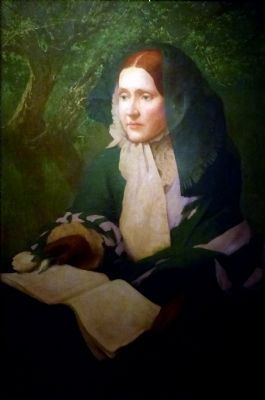
Photographed By Allen C. Browne, February 16, 2015
7. Julia Ward Howe
This portrait begun by John Elliot in 1910 and finished by William H. Cotton c. 1925 hangs in the National Portrait Gallery in Washington DC.
“For years Julia Ward Howe yearned to take a more active part in public affairs. But her husband, the noted Boston reformer Samuel Gridley Howe, insisted that she confine herself to running their home. In 1861, however, she unwittingly transformed her-self into a minor celebrity by writing the ‘Battle Hymn of the Republic.’ Composed during a visit to Washington, this fiercely martial poem, dedicated to the Union cause, was set to the music of ‘John Brown's Body.’ By 1865 it had become the North's unofficial wartime anthem.
After the Civil War, Howe finally broke the constraints imposed by her husband to become one of the best-loved figures in the growing women's suffrage movement. This portrait was begun in Howe's last years by her son-in-law, who attempted to portray her as she might have looked years earlier, writing the ‘Battle Hymn.’” — National Portrait Gallery
“For years Julia Ward Howe yearned to take a more active part in public affairs. But her husband, the noted Boston reformer Samuel Gridley Howe, insisted that she confine herself to running their home. In 1861, however, she unwittingly transformed her-self into a minor celebrity by writing the ‘Battle Hymn of the Republic.’ Composed during a visit to Washington, this fiercely martial poem, dedicated to the Union cause, was set to the music of ‘John Brown's Body.’ By 1865 it had become the North's unofficial wartime anthem.
After the Civil War, Howe finally broke the constraints imposed by her husband to become one of the best-loved figures in the growing women's suffrage movement. This portrait was begun in Howe's last years by her son-in-law, who attempted to portray her as she might have looked years earlier, writing the ‘Battle Hymn.’” — National Portrait Gallery
Credits. This page was last revised on January 30, 2023. It was originally submitted on March 28, 2008, by Richard E. Miller of Oxon Hill, Maryland. This page has been viewed 3,173 times since then and 36 times this year. It was the Marker of the Week November 20, 2011. Photos: 1, 2. submitted on March 28, 2008, by Richard E. Miller of Oxon Hill, Maryland. 3. submitted on November 19, 2011, by J. J. Prats of Powell, Ohio. 4. submitted on March 28, 2008, by Richard E. Miller of Oxon Hill, Maryland. 5. submitted on April 23, 2015, by Allen C. Browne of Silver Spring, Maryland. 6. submitted on September 13, 2016, by J. Makali Bruton of Accra, Ghana. 7, 8. submitted on April 23, 2015, by Allen C. Browne of Silver Spring, Maryland. • Craig Swain was the editor who published this page.
